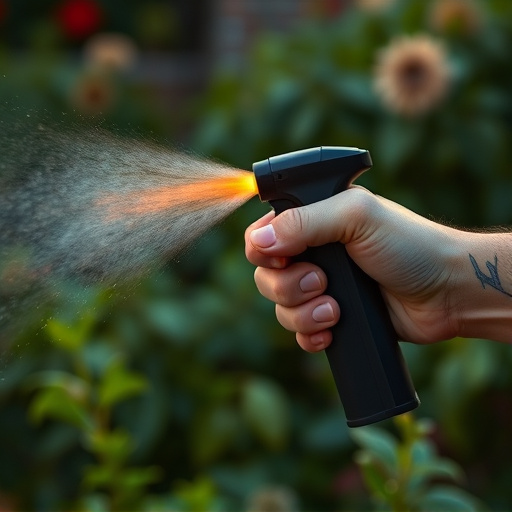Pepper spray, with capsaicin as its active ingredient, is a self-defense tool against bears. Proper storage in cars involves keeping it out of direct sunlight and extreme temperatures in a secure, dedicated compartment. Regular maintenance includes checking expiration dates. Misuse or improper storage poses risks; practice responsible handling and keep it secured. Strength varies by bear species; select accordingly for hiking and camping safety.
In regions where wildlife encounters are common, understanding bear spray defense is crucial. This comprehensive guide explores the effectiveness of pepper spray against animal attacks, offering insights on proper storage practices, safety tips for in-car usage, and strategies to avoid critical mistakes during emergencies. Learn how to choose the right bear spray tailored to your needs, ensuring optimal preparedness while navigating through potential wildlife hazards. Discover essential tips for secure pepper spray storage in your vehicle, a game changer for safe outdoor adventures.
- Understanding Bear Spray Effectiveness
- Correct Storage Practices for Pepper Spray
- Safety Tips When Using Bear Spray in Cars
- Common Mistakes to Avoid During Emergencies
- Choosing the Right Bear Spray for Your Needs
Understanding Bear Spray Effectiveness
Bear spray, also known as pepper spray, is a popular self-defense tool for outdoor enthusiasts and those living in bear country. When faced with an aggressive bear, a quick application of bear spray can create a barrier, temporarily blinding and disorienting the animal, allowing you to escape unharmed.
The effectiveness of bear spray lies in its active ingredient—capsaicin, which is found in chili peppers. This irritant targets the bear’s eyes, nose, and respiratory system, causing a strong reaction. Proper usage involves aiming for the bear’s face and eyes from a safe distance, typically around 20-30 feet (6-9 meters). However, it’s crucial to remember that bear spray is not a foolproof solution. Storage of pepper spray in your car or on your person is essential, ensuring it remains accessible during encounters. Regular maintenance and checking of expiration dates are also vital to guarantee its potency when needed.
Correct Storage Practices for Pepper Spray
Proper storage of pepper spray, especially in a vehicle, is paramount for its effectiveness and safety. It’s crucial to keep it out of direct sunlight, extreme heat or cold, and store it in a secure, dedicated compartment. Many modern vehicles come equipped with specialized compartments designed precisely for this purpose. If not provided by the manufacturer, consider installing an aftermarket storage solution that ensures the spray remains sealed, untouched, and at optimal temperature conditions.
When stowed correctly, pepper spray should be easily accessible in case of an emergency. Keep it within arm’s reach, but avoid placing it near hot air vents or any other potential sources of heat. Regularly check the expiration date and ensure the canister is intact and unharmed to guarantee its potency. This simple practice can significantly enhance your safety while driving or traveling through areas with known wildlife risks.
Safety Tips When Using Bear Spray in Cars
When storing bear spray in your car, ensure it’s out of reach of children and pets, and securely fastened to prevent rolling or shifting during travel. Keep it in an easily accessible location, like the center console or glove compartment, so you can quickly grab it if needed. Always remember to check local laws regarding pepper spray storage in vehicles, as regulations can vary by region.
Before driving off, familiarize yourself with how to deploy the spray properly. Practice making quick movements to activate it while wearing gloves, as this will minimize any potential irritation from direct contact. Regularly inspect your bear spray for any signs of damage or expiration and replace it promptly if needed.
Common Mistakes to Avoid During Emergencies
During emergencies, panicking or making impulsive decisions can worsen the situation. One common mistake is misusing bear spray, such as spraying in a panic instead of aiming for the animal’s face. Always remember that bear spray is not a weapon; it’s a tool to deter an attack. Improper storage is another blunder; keeping pepper spray in plain sight or easily accessible without proper containment can lead to accidental use or theft, which could prove dangerous. Ensure your bear spray is stored safely in your car, out of reach from children and other passengers, and clearly labeled for easy identification during emergencies. Regularly check the expiration date and keep a spare in your backpack when hiking to be fully prepared.
Choosing the Right Bear Spray for Your Needs
When selecting bear spray, consider your specific needs and environment. Different regions have varying bear species and behaviors, so choose a spray with an appropriate concentration and range. For instance, if you’re hiking in areas with black bears, opt for a lower-strength spray as they are less aggressive than grizzly bears.
Storing pepper spray in your car is a wise idea for quick access during unexpected encounters. Keep it readily available, easily reachable, and secured to prevent accidental discharge. Regularly check the expiration date and practice using it periodically to ensure its effectiveness.
Bear spray, also known as pepper spray, is a powerful tool for self-defense against bear attacks. By understanding its effectiveness, proper storage practices (including safe Pepper Spray Storage in Car), and safety tips for use, you can significantly increase your chances of survival in the event of an encounter. Avoid common mistakes and choose the right bear spray tailored to your specific needs, ensuring you’re prepared should you find yourself in a potentially dangerous situation with these majestic yet unpredictable creatures.
